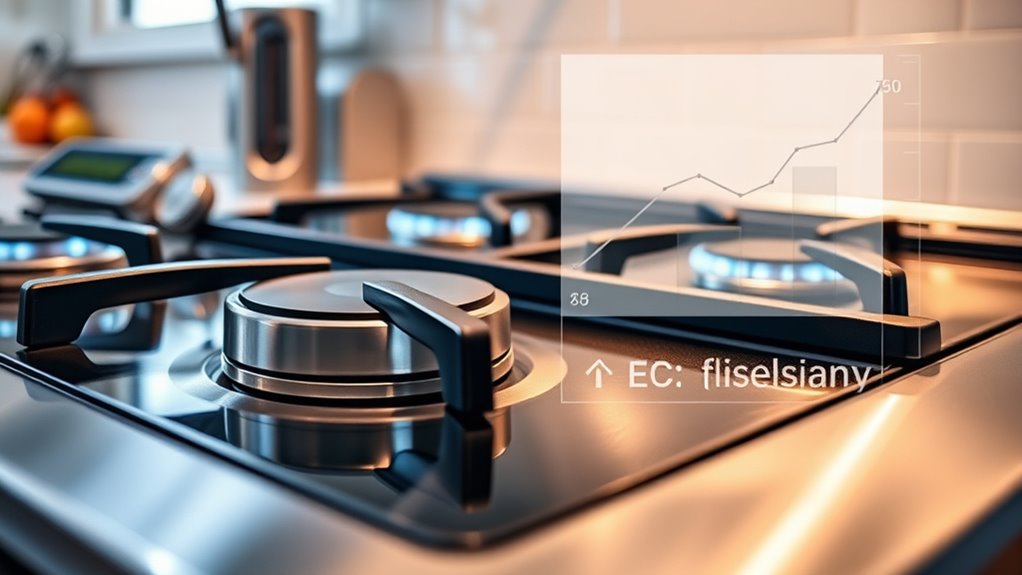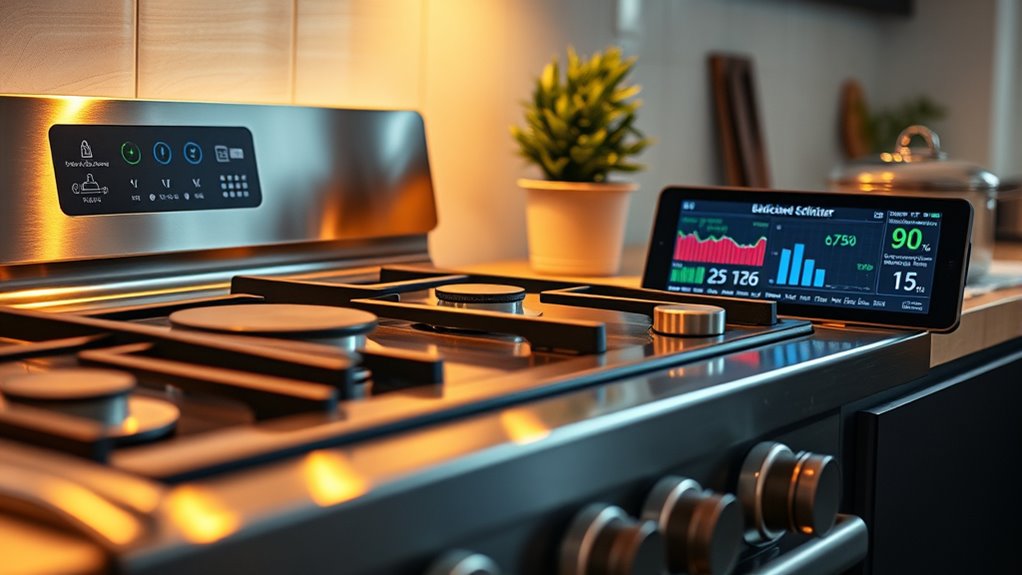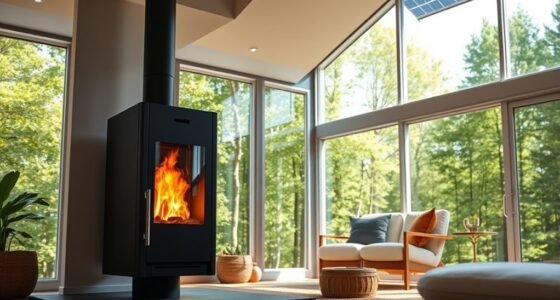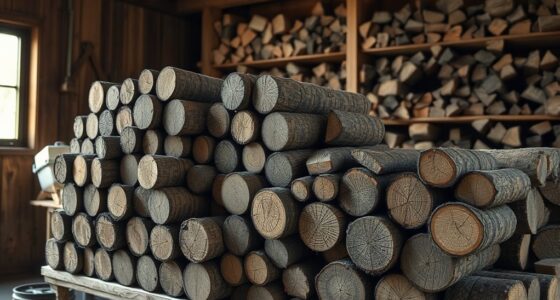To calculate your stove’s efficiency and environmental impact, start by measuring fuel use versus heat output. Focus on proper combustion with seasoned fuel and regular maintenance, which improve efficiency and lower emissions. Adjusting air flow and managing burn times can also help. Using certified, high-efficiency stoves guarantees safer, greener operation. Keep an eye on performance and consider upgrades—more tips on optimizing your stove’s performance and reducing its environmental footprint await.
Key Takeaways
- Measure fuel input versus heat output to determine thermal efficiency, using tools like efficiency calculators or stove testing data.
- Assess combustion completeness by inspecting smoke color and emissions, indicating how efficiently the stove burns fuel.
- Calculate greenhouse gas emissions based on fuel type, consumption rates, and combustion efficiency to estimate environmental impact.
- Use thermal efficiency ratings and emission standards (e.g., EPA certifications) to compare stove performance and environmental effects.
- Regularly monitor and maintain your stove to ensure optimal efficiency and minimize pollutant emissions over time.

Stoves play a critical role in our daily lives, but their efficiency directly affects both energy consumption and the environment. When you’re using your stove, it’s necessary to consider how well it converts fuel into heat. An efficient stove minimizes fuel consumption, saving you money and reducing your carbon footprint. But beyond cost, safety is paramount. Fire safety should always be a top priority when evaluating your stove’s performance. A poorly maintained or outdated stove can pose risks of leaks, fires, or carbon monoxide poisoning, so making sure your appliance is functioning correctly is essential.
Efficient, well-maintained stoves are vital for safety, saving money, and protecting the environment.
To start, understanding your stove’s fuel consumption is key. The more efficiently your stove uses fuel, the less energy you waste. This means choosing models with high thermal efficiency ratings or adopting practices that improve combustion. For example, using properly seasoned wood, maintaining clear vents, and making certain your stove is free of blockages helps achieve complete combustion. Complete combustion not only improves heat output but also reduces emissions of harmful pollutants and unburned fuel particles. This directly impacts your environmental footprint, as inefficient burning releases more greenhouse gases and particulates into the air. Additionally, selecting vetted products designed for optimal efficiency can further enhance performance and safety.
Fire safety also ties into how you manage your stove’s fuel. Using the right type and amount of fuel prevents dangerous situations like flare-ups or smoke buildup. Overloading a stove or using inappropriate fuels can cause overheating, increase the risk of fire, or produce hazardous fumes. Regular inspections and prompt repairs are critical to maintaining both fire safety and efficiency. A well-maintained stove with a good seal prevents leaks of dangerous gases, and proper ventilation ensures these gases don’t accumulate indoors, further reducing health hazards and environmental impact.
Evaluating your stove’s efficiency involves more than just fuel type; it also includes how you operate it. Adjusting air intake, managing burn times, and using thermostatic controls help optimize performance. These practices not only cut down on fuel consumption but also lessen the environmental impact by reducing unnecessary emissions. Additionally, upgrading to a more modern, energy-efficient stove can dramatically improve fuel economy and safety standards, providing long-term benefits.
Frequently Asked Questions
How Often Should I Clean My Stove for Optimal Efficiency?
You should clean your stove at least once a month for peak efficiency. Follow a regular cleaning schedule to prevent buildup and guarantee safe operation. Use basic maintenance tips like wiping down surfaces after each use and checking burners for clogs. If you notice uneven heating or reduced performance, increase cleaning frequency. Staying consistent with your cleaning schedule helps your stove run smoothly, saves energy, and extends its lifespan.
What Are the Best Practices to Reduce Emissions During Cooking?
To reduce emissions during cooking, prioritize good ventilation strategies by using exhaust fans or opening windows. Keep your indoor air quality high by avoiding the buildup of fumes, and guarantee your stove is well-maintained for cleaner combustion. You should also cook with lids on pots to contain emissions and avoid burning unnecessary items. These practices help minimize indoor pollutants, making your kitchen safer and more environmentally friendly.
How Does Fuel Type Affect My Stove’s Environmental Impact?
Oh, choosing your fuel type is like picking a superhero costume—some options save the planet more than others. Using fossil fuels boosts fuel emissions, harming your environment, while renewable options like solar or bioethanol slash your impact. By switching, you’re not just cooking; you’re making a statement. Opt for greener fuels to reduce emissions and embrace sustainability, because your stove’s choice can turn you into an eco-hero—minus the cape.
Can Stove Upgrades Improve Energy Efficiency Significantly?
Yes, stove upgrades can considerably improve energy efficiency. When you invest in newer models or enhance your current stove with energy-saving tips, you boost stove performance and reduce energy waste. Upgrades like better insulation, more precise controls, or high-efficiency burners help you save money and cut environmental impact. By focusing on stove performance, you guarantee your appliance uses less fuel, making your cooking more sustainable and cost-effective.
Are There Government Incentives for Using Eco-Friendly Stoves?
Did you know that many governments offer incentives to encourage eco-friendly stove use? Yes, you can often access government incentives and eco-friendly rebates that help offset the cost of upgrading. These programs aim to reduce emissions and improve energy efficiency. Check your local energy agencies or government websites to discover available incentives in your area, making sustainable choices more affordable and easier to implement.
Conclusion
Now that you understand how to calculate your stove’s efficiency and assess its environmental impact, the real question is: what will you do next? Will you make changes to reduce emissions and save energy, or continue with the status quo? The choices you make now could shape not just your home’s future, but the planet’s. The power to make a difference lies in your hands — but the true impact remains to be seen.











